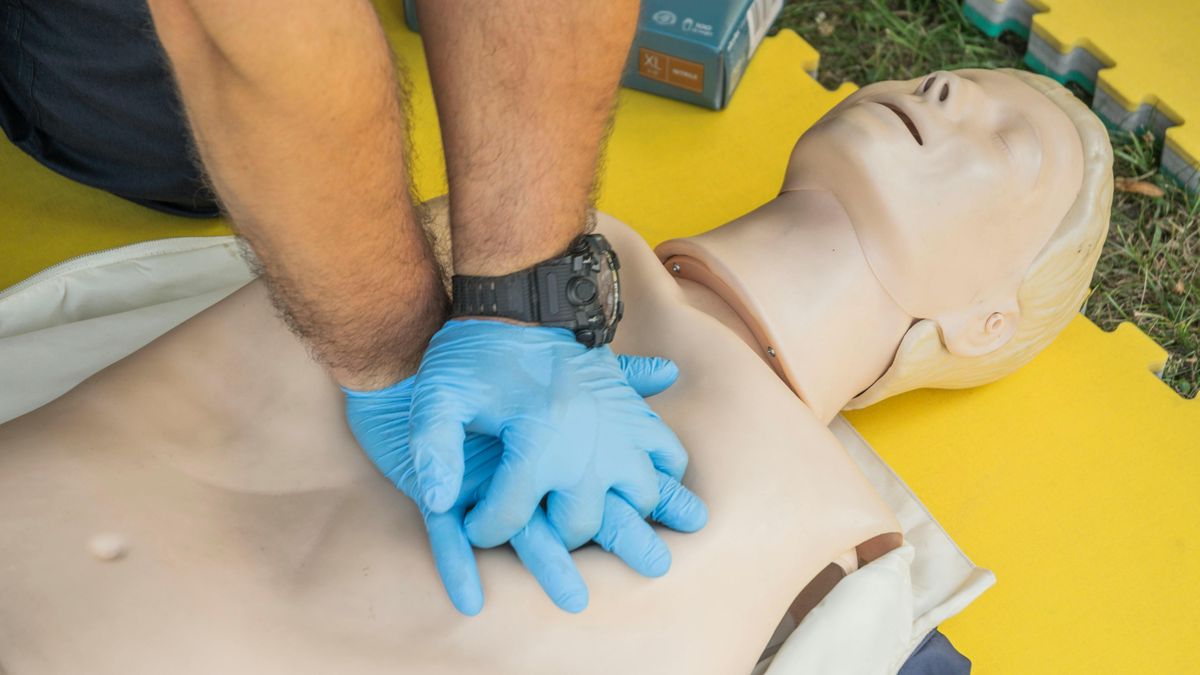This information may be provided by the victim or by witnesses.
2. Quickly assess the general condition of the victim.
Assessment should be quick, limited, and simple. Gently move the patient by the shoulders and ask, “How do they feel?” “What is their chief complaint?” “Is they responsive or unconscious?” “Is air getting into their lungs?” “If they are breathing, are they breathing well or poorly (gasping, making noises)?” “Is there any visible external bleeding?”
3. According to the overall assessment, the health emergency system must be activated.
Beginning of the life chain: activate the emergency call, to ensure advanced care and eventual transfer to a health center. This phone call can be made by the rescuer or by a third party designated by him, to an emergency health service (he must know the emergency numbers in his area) or, if it is not possible, call the fire department or the police.
4. Assist the victim according to their needs.
Assist the victim according to the problem found: bleeding, fainting, among others. Never leave the person (victim) alone until the health team or someone with more experience arrives to take charge.
What should not be done?
Never improvise if you don’t know how. If you have knowledge, you should act calmly and as quickly as possible and dedicate yourself first to what involves life.
The victim should not be moved abruptly or allowed to stand up. Never leave the victim alone or speak loudly to him or her about his or her condition.
In the event that the Emergency Services are not available, whenever possible, transfer the victim to the nearest health centre (remember not to move or transfer a victim of violent or severe trauma). Pay special attention when transferring children, since moving them can easily aggravate a traumatic injury or increase the pain.
The most frequent incidents that we may encounter and apply first aid to may be: cardiorespiratory arrest, asphyxiation due to aspiration of foreign bodies, electrocution, burns, sunstroke or heat stroke; wounds caused by cuts or blows, stab wounds and firearms; hemorrhages; sprains, dislocations and fractures; bites and stings; poisoning, road accidents and loss of consciousness and convulsions.
In the event of an episode of cardiorespiratory arrest, the first aid procedure is to perform Cardiopulmonary Resuscitation.
In relation to CPR, the maneuvers to be performed are:
1. Lay the unconscious person on a hard surface on his or her back.
2. Place the rescuer’s hands on top of each other with palms down and fingers interlaced.
3. Perform between 100 and 120 compressions per minute, sinking the chest by approximately 5 cm.
4. Compressions should be rhythmic (same compression as relaxation).
5. Change resuscitators every 1 to 2 minutes to avoid fatigue and thus avoid ineffective maneuvers.
6. Once the AED is obtained, a second operator must connect it to the victim while continuing to perform compressions. Once the device is connected, it will tell us when to stop performing compressions and when to resume them.
In the case of pediatric CPR:
1. Check for airway obstruction.
2. Start compressions at the same frequency as in adults, checking that the chest descends 1/3 of its height.
3. The position of your hands on the chest varies depending on the age of the child; you should place your index and middle fingers in the center of the sternum, between the nipples, or with both thumbs. In older children, full-hand compressions may be required.
4. Give 2 breaths of 1 second each, lightly blowing, to raise the baby’s chest.
5. Alternate 30 compressions and 2 breaths until the ambulance arrives.
6. Once the AED is obtained, a second operator must connect it to the victim while continuing to perform compressions and breaths. Once the device is connected, it will tell us when to stop performing compressions and when to resume them.
In both cases, these maneuvers must be carried out until the ambulance arrives.
In the event of electrocution, it is not recommended to use metal objects to separate the victim from the current or to remove the injured person by passing your arms under their armpits, which are a means of electrical conduction when sweaty.
first aid (2).jpg
In case a burn occurs it is important to:
1. Reassure the person.
2. Contact a health care service and notify a known family member of the affected person.
3. Cool the burned area for several minutes with cold (never ice cold) clean water or saline solution on the injury to cool the burn.
4. Remove any clothing that is not stuck to the burned area.
5. Cover the wound with a clean dressing.
6. Keep the person in a warm environment to avoid hypothermia (low temperature).
7. Administer plenty of fluids orally, as long as the injured person is conscious.
8. Arrange transfer to a specialized care center as soon as possible.
9. Cover the dressing with a clean, dry cloth.
Actions you should NOT perform:
1. Do not break the blisters. This will prevent infection and further trauma.
2. Do not apply ointments, butter, ice, oils, toothpaste, meat, tomato, aloe vera, urine etc.
3. Do not apply dry bandages, lint-based bandages or any home remedies.
4. Do not touch, blow or breathe on the burn.
5. Do not touch or remove blistered or raised skin.
In case of injury it is recommended:
1. Use latex gloves to avoid contracting any disease or contaminating the wound.
2. Remove the clothing covering the wound.
3. Clean the wound well with soap and water, gauze and saline solution or drinking water, removing excess blood and any dirt it may have.
4. Apply an antiseptic, such as povidone iodine or chlorhexidine, to prevent possible infections.
5. Protect the wound with clean gauze and NOT cotton.
6. Apply ice immediately after a blow, in the case of a bruised wound.
7. Place warm cloths on the area to reduce swelling once the injury site turns purple.
8. In case of cuts or puncture wounds, press firmly on the wound with a handkerchief or simply with your hand, trying to bring the edges of the wound together and thus prevent blood loss.
9. Apply clean bandages. If blood seeps through the bandages, place another one on top of them. Never remove the previous bandage.
10. If the injury is caused by a knife or gunshot, contact a medical service and notify a family member or acquaintance of the person.
11. If the penetrated object remains in the body, immobilize it with gauze or a clean cloth and apply a bandage to prevent movement during transport.
It is NOT recommended:
1. Do not apply any type of home remedy because they can cause infections.
2. Do not apply any medications or antibiotics as this may cause an allergic reaction.
3. Touch the wound with your fingers.
4. Put cotton on the wounds.
5. Remove the penetrated object in case of a stab wound, gunshot wound or any other injury.
Source: Ambito
I am Pierce Boyd, a driven and ambitious professional working in the news industry. I have been writing for 24 Hours Worlds for over five years, specializing in sports section coverage. During my tenure at the publication, I have built an impressive portfolio of articles that has earned me a reputation as an experienced journalist and content creator.




